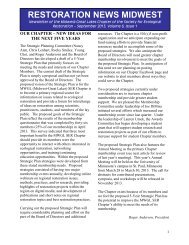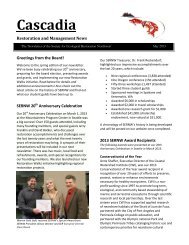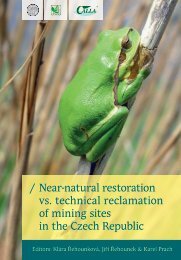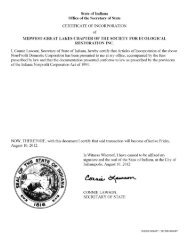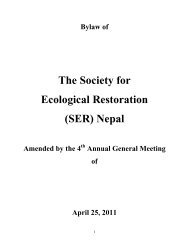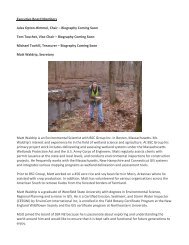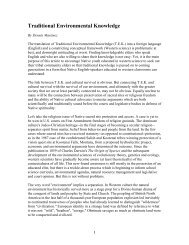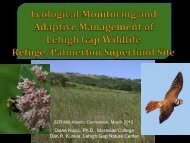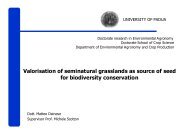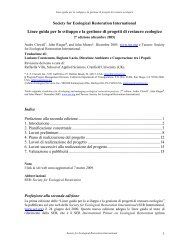THE WORLD CONFERENCE ON ECOLOGICAL RESTORATION
A Global Challenge - Society for Ecological Restoration
A Global Challenge - Society for Ecological Restoration
You also want an ePaper? Increase the reach of your titles
YUMPU automatically turns print PDFs into web optimized ePapers that Google loves.
2005 The World Conference on Ecological Restoration 35<br />
ture of 100-year old regenerating redwood stands managed under variable retention. Increment core data<br />
were used to reconstruct recent diameter growth rates, tree and stand volume growth. Tree height, live<br />
crown length, and branch-free trunk length data were used to describe vertical stand structure, and were<br />
depicted graphically, complemented by color slides of the regenerating stands. Leaf area index and stand<br />
density index were calculated and compared with data from old growth and regenerating stands. The<br />
growth and vigor of the new cohort initiated by the restorative harvest treatment was assessed in small<br />
subplots. The future growth of these trees, and other understory cohorts initiated by future harvest treatments<br />
was discussed with reference to estimates of future canopy tree growth, crown expansion, and<br />
growing space occupancy within the restored structure. Data collected within adjacent undisturbed redwood<br />
stands were used to derive indicative variable retention harvest yields. The average diameter, height<br />
and cubic volume of cut trees will inform managers interested in producing forest floor log debris or deriving<br />
returns from restorative variable retention harvest treatments. Once key structural elements and features<br />
of old-growth redwood stands have been defined, the data and results presented herein could guide<br />
future restoration efforts aimed at meeting defined structural goals for old-growth restoration.<br />
Keywords: Old-growth, redwood, Sequoia sempervirens, restoration, variable retention.<br />
Bio-geo-chemical Cycles and their practical implications in Management of<br />
Degraded Sites by Restoration Forestry<br />
Bhojvaid P.P.<br />
Conservator of Forests, South Circle, Gurgaon, Haryana, India<br />
One of the main objectives of ‘Restoration Forestry’ is to suggest the management options for improving<br />
degraded soil fertility through biological processes of trees. This aspect was formulated on the premise<br />
that the sustainable productivity of a natural ecosystem is derived to a great extent from the bio-geochemical<br />
processes of litter and soil. These processes include biomass and nutrient accumulation by carbon<br />
assimilation, nutrient recycling by litter fall, root turnover and their subsequent decomposition and<br />
decay resulting in humus synthesis. The soil fertility build up and its sustainability is dependent not<br />
only on the maintenance of these activities at certain critical levels but even more importantly on their<br />
functioning as an integrated system with regulatory mechanisms operating in a synchronized manner.<br />
Essentially it means making the acyclic processes more cyclic thereby leading to the improvement of<br />
structure and function of an ecosystem. Little, however, is known about the mechanism of these effects<br />
especially with respect to restoration of degraded sites by tree planting. The discussion in this paper is<br />
focused on these aspects of restoration forestry and their importance in field management based on biogeo-chemical<br />
cycles of plantations raised for restoration of various categories of degraded sites such as<br />
saline, sodic, sand dunes, waterlogged and mined spoils. It is envisaged that a judicious decision on<br />
management of a restored area would depend on such rotations that maintain and sustain the cyclic nature<br />
of ecosystems without jeopardizing the production from such areas.<br />
Keywords: Ecosystem degradation- Ecological rotation- Restoration forestry-Sustainability.<br />
Biomass and nutrient accumulation in restoration plantations of an age<br />
sequence of Prosopis juliflora (Swartz) DC grown on degraded sodic soils in<br />
Haryana, India<br />
Bhojvaid P.P.<br />
Conservator of Forests, South Circle, Gurgaon, Haryana. India<br />
The objective of this study is to address the issue of sustainbilty of management options for Prosopis<br />
juliflora plantations raised on sodic soils in Haryana, India set up primarily for the purpose of soil reclamation.<br />
Sustainability, in the context of this study, is defined as the maintenance and/or enhancement<br />
of organic matter and nutrient build up in the soils, which is driven by carbon assimilation and photosynthesis<br />
in the living biomass and the return of organic matter to soil via litterfall and root turnover.<br />
The approach taken was to monitor these indicators of sustainabilty along a gradient of increasing tree<br />
biomass, detritus biomass and under-storey development and corresponding changes in soil organic<br />
matter and nutrient build up in a 0-, 5-, 7- and 30 year old chronosequence. The intention was to examine<br />
the sustainability of management recommendations in relation to temporal patterns of biomass and<br />
nutrient accumulation in an age sequence of Prosopis juliflora. Specific objectives were to: (1) examine<br />
nutrient budgets, nutrient cycling and growth partitioning in the age sequence, (2) to study dynamics of<br />
nutrient storage in soil and vegetation biomass over time, and (3) to examine the changes in understorey<br />
community structure in the Prosopis chronosequence.<br />
Keywords: Sodic soils, Sustainability, Restoration, Chronosequence, Nutrient Budgets.



